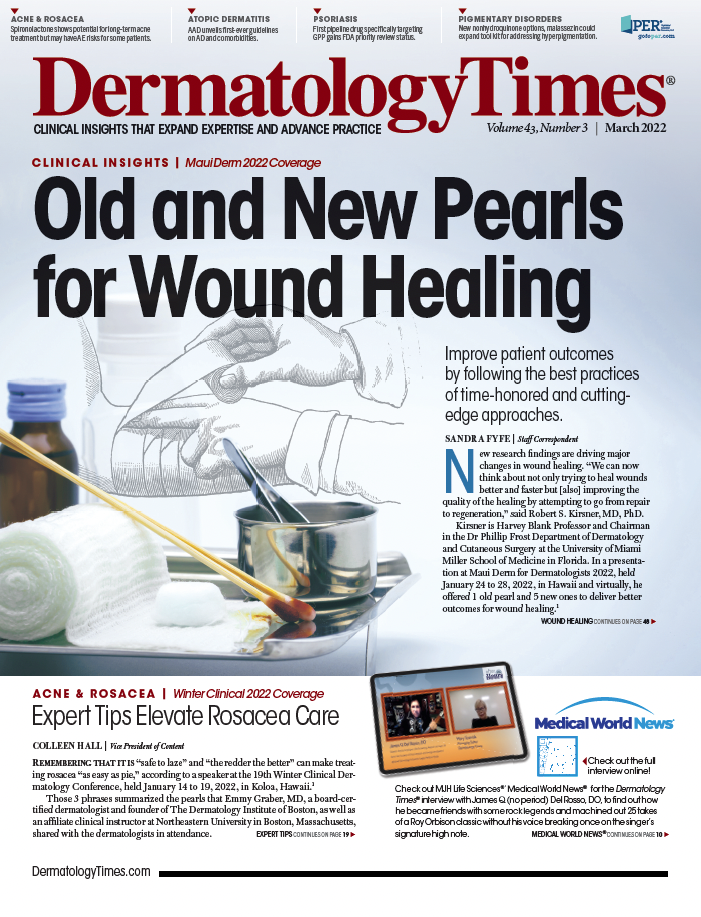- Case-Based Roundtable
- General Dermatology
- Eczema
- Chronic Hand Eczema
- Alopecia
- Aesthetics
- Vitiligo
- COVID-19
- Actinic Keratosis
- Precision Medicine and Biologics
- Rare Disease
- Wound Care
- Rosacea
- Psoriasis
- Psoriatic Arthritis
- Atopic Dermatitis
- Melasma
- NP and PA
- Skin Cancer
- Hidradenitis Suppurativa
- Drug Watch
- Pigmentary Disorders
- Acne
- Pediatric Dermatology
- Practice Management
- Prurigo Nodularis
- Buy-and-Bill
Publication
Article
Dermatology Times
Using 31-GEP and Clinicopatholic Data to Determine RFS in Skin Cancer
Author(s):
Poster presented at Maui Derm for Dermatologists 2022 reveals prognostic value of 2 independently validated algorithms.
Integrating the combined ability of 2 independently validated algorithms using 31-gene expression profile (GEP) test (Castle Biosciences Inc) with clinicopathologic features may play a role in predicting the individual risk of sentinel lymph node (SLN) risk and recurrence-free survival (RFS) according to a poster presented at Maui Derm for Dermatologists 2022, being held Jan. 24-28, 2022, in Maui, Hawaii.1,2
Using artificial intelligence (AI), an algorithm was created from 1,398 cases to determine the likelihood of SLN positivity. It was validated in a separate cohort of 1,674 cases (i31-GEP-SLNB). A different algorithm for personalized survival predictions for RFS, distant metastasis-free survival (DMFS), and melanoma-specific survival (MSS) was developed from 1,581 cases and were validated in an independent cohort of 523 cases (i31-GEP-outcomes). Based on the available data, 98% of patients in the validation cohort did not receive programmed cell death protein (PD)-1, cytotoxic T-lymphocyte-associated protein (CTLA)-4, or BRAF/MEK adjuvant therapy, according to the poster.
Risk cut-off point was created to align with the National Comprehensive Cancer Network (NCCN) guidelines. The decided cut-off were the midpoints between stage IIA and IIB (RFS: 69.8%; DMFS: 82.6%). All outcomes with i31-GEP-outcomes predicted RFS or DMFS higher than the cut-off were classified as low risk. Otherwise, they were classified as high risk.2
To determine the prognostic value of both algorithms, 433 patients that were not used in either algorithm development were then analyzed by i31-GEP- SLNB, followed by i31-GEP-outcomes.
The 5-year RFS for patients with SLN negative populations were:
- Low risk (n=172): 86.7% (81.2-92.7%) with a 95% CI. There were 10.5% (18/172) that experienced recurrences.
- SLN Negative (n=215): 79.2% (73.4-85.5%) with a 95% CI. There were 17.7% (38/215) that experienced recurrences.
- High Risk (n=43): 47.7% (33.6-67.7%) with a 95% CI. There were 46.5% (20/43) that experienced recurrences.
The 5-year RFS for patients with SLN positive populations were:
- Low risk (n=16): 85.9% (69.5-100%) with a 95% CI. There were 18.8% (3/16) that experienced recurrences.
- SLN positive (n=83): 48.7% (37.6-63.1%) with a 95% CI. There were 45.8% (38/83) that experienced recurrences.
- High risk (n=67): 37.9% (25.8-55.6%) with a 95% CI. There were 52.2% (35/67) that experienced recurrences.
Comparing this data for the 5-year RFS and DMFS for patients with stage IIB-IIC disease shows that the low-risk group for both RFS and DMFS had 0% recurrences or distant metastases. In the stage IIB/IIC group, 34.7% and 26.5%, respectively, experienced recurrences or distant metastases. In the high-risk group, 45.9% and 58.3%, respectively, experienced recurrences or distant metastases.
The data showed that the i31-GEP for SLNB algorithm identified 31.2% (135/433) of patients with a less than 5% likelihood of SLN positivity and these patients had high survival rates. This means that these patients could safely forego SLNB, according to researchers.2 Also, in the SLN negative population, 20% of patients identified as high risk by the i31-GEP result and had 5- year RFS rates that were identical to patients with stage III disease (47.7% vs. 48.7%, respectively).2
“Overall, using NCCN treatment recommendations, the i31-GEP test identified 44.8% (194/433) of patients need to add how they were identified and what this meant.Take that from results or conclusions,” the authors concluded.
Reference:
- Castle Biosciences to present data at Maui Derm for Dermatologists 2022. BioSpace. Published January 24, 2021. Accessed January 27, 2022. https://www.biospace.com/article/castle-biosciences-to-present-data-at-maui-derm-for-dermatologists-2022/
- Martin, B. Taylor, N. Whitman, E. et al. Integrating the 31-gene expression profile and clinicopathologic data to determine the risk of sentinel lymph node positivity and recurrence-free survival in cutaneous melanoma. Presented at: Maui Derm 2022; January 24 to 28, 2022; Wailea, Hawaii.







